Where: At home, Outdoors
When: In the afternoon, just after about 2.pm. when the sun was high enough in the sky to provide light with slight cloud.
How: In each part of the exercise; Having positioned the subject in a chair with a plain hedge behind her, using the first lens which was a 70-300 I moved as far away as possible and framed the portrait.
I noticed that the light was not as bright as I wanted and that the light was a little too blue through the clouds giving the image a cold blue cast. I setup a small camera flash unit to fire remotely. Setting it on half power and covering the flash head with a small orange filter adjusted the light colour giving a warmer look to the images.
Moving towards the subject I zoomed the lens focal length down trying to keep the framing the same size and position as possible. I had to adjust the camera position and the tripod several times during the exercise to keep the framing the same for all three positions and setups as I found that the closer to the subject I got, the higher the tripod had to be. When the 70-300mm lens became unusable as I could no longer zoom in or out I changed to an 18-70mm lens and continued moving in to the subject.
Having used zoom lenses before in taking portraits I knew that they can be used to create simple but stunning portraits as the zoom lens has the tendency to flatten the overall image due to its optics. A few years ago I shot this indoors self portrait using a zoom lens at 110mm and two low powered studio lamps.
A Self portrait.
Nikon D50,Exposure Mode Manual, focal length 110.0mm (35mm equivalent 142mm), aperture f11, speed 1/500 second, ISO 200, Auto white balance, Centre Weight metering, tripod mounted camera, 55-200 lens, Small studio lights to the subjects left and right both studio lights were at half power level and were fitted with diffusers.
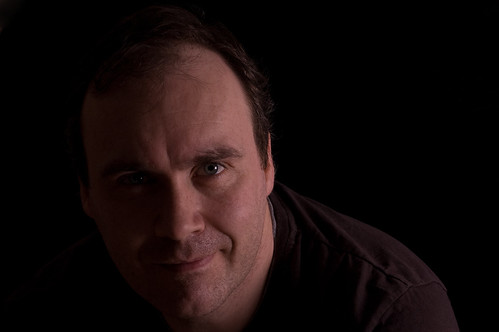
With this exercise again I used RAW and JPEG setting on the camera so that I could quickly review the images shot so that I could reshoot where necessary. I was planning to shoot with the camera tethered but the spots of rain that came and went made me choose not to use the laptop just in case it rained.
Head and Shoulders
I started as far back as I could go in the garden and with the lens at the maximum focal length where I could contain the subjects head within the frame I started to shoot, moving the focal length downwards as I went.
DSC_0020
Nikon D80,Exposure Mode Manual, focal length 240.0mm (35mm equivalent 360mm), aperture f8, speed 1/180 second, ISO 250, Shade white balance, Spot metering, tripod mounted camera, 70-300 lens, Small flash to the subjects right with a colour balancing sheet fitted on the flash head.

I chose the aperture of f/8.0 as I did not want have a narrow depth of field.
After reviewing the image I decide that I had not framed her head correctly, so I moved the focal length of the zoom lens down a bit until I was happier with the framing.
DSC_0021
Nikon D80, Exposure Mode Manual, focal length 195.0mm (35mm equivalent 292mm), aperture f8, speed 1/180 second, ISO 250, Shade white balance, Spot metering, tripod mounted camera, 70-300 lens, Small flash to the subjects right with a colour balancing sheet fitted on the flash head.

DSC_0024
Nikon D80, Exposure Mode Manual, focal length 70.0mm (35mm equivalent 105mm), aperture f8, speed 1/180 second, ISO 250, Shade white balance, Spot metering, tripod mounted camera, 18-70mm lens, Small flash to the subjects right with a colour balancing sheet fitted on the flash head.

DSC_0026
Nikon D80, Exposure Mode Manual, focal length 18.0mm (35mm equivalent 27mm), aperture f8, speed 1/180 second, ISO 250, Shade white balance, Spot metering, tripod mounted camera, 18-70mm lens, Small flash to the subjects right with a colour balancing sheet fitted on the flash head.
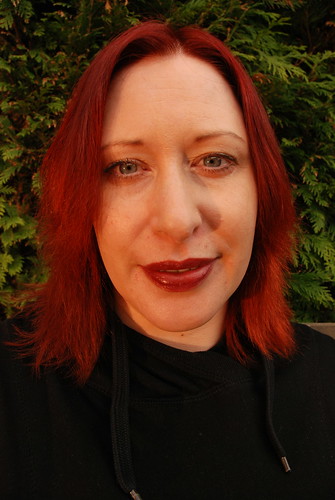
The lens distortion at 18mm renders the image unusable; it looks like it was photographed in a hall of mirrors. While the effect may be suitable for a different style of portraiture it is not suitable here!
Torso Portrait
Again I chose an aperture of f/8 to ensure that none of the image was rendered out of focus by the depth of field.
DSC_0019
Nikon D80, Exposure Mode Manual, focal length 125mm (35mm equivalent 187mm), aperture f8, speed 1/180 second, ISO 250, Shade white balance, Spot metering, tripod mounted camera, 70-300mm lens, Small flash to the subjects right with a colour balancing sheet fitted on the flash head.
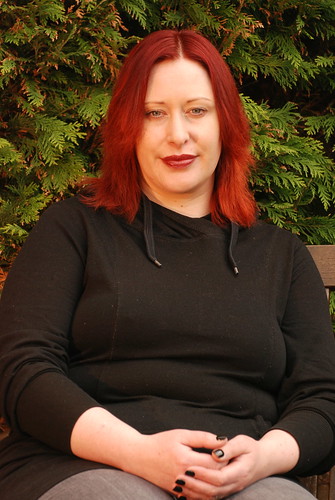
DSC_0016
Nikon D80, Exposure Mode Manual, focal length 95mm (35mm equivalent 142mm), aperture f8, speed 1/180 second, ISO 250, Shade white balance, Spot metering, tripod mounted camera, 70-300mm lens, Small flash to the subjects right with a colour balancing sheet fitted on the flash head.

DSC_0014
Nikon D80, Exposure Mode Manual, focal length 52.0mm (35mm equivalent 78mm), aperture f8, speed 1/180 second, ISO 250, Shade white balance, Spot metering, tripod mounted camera, 18-70mm lens, Small flash to the subjects right with a colour balancing sheet fitted on the flash head.
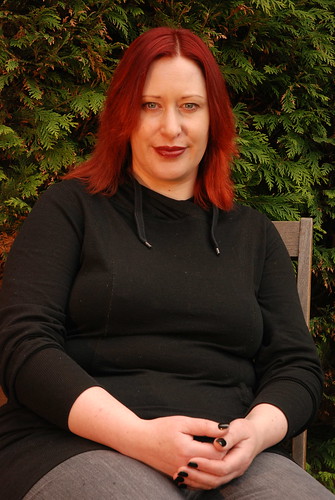
DSC_0011
Nikon D80, Exposure Mode Manual, focal length 18.0mm (35mm equivalent 27mm), aperture f8, speed 1/180 second, ISO 250, Shade white balance, Spot metering, tripod mounted camera, 18-70mm lens, Small flash to the subjects right with a colour balancing sheet fitted on the flash head.
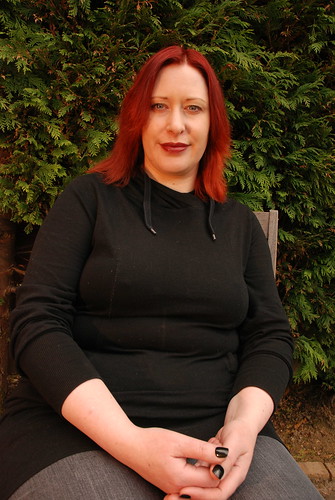
Again on closer review of the images I can see that the focal length of 18mm has made the image slightly distorted in the middle centre of the frame. It makes thesubject look like she was leaning back instead of sitting straight up. An unusual effect which could be used to my advantage at some point.
Full Length Portrait
Sticking with the same aperture, I performed the last part of the exercise, repeating the movement in towards the subject.
DSC_0010
Nikon D80, Exposure Mode Manual, focal length 70.0mm (35mm equivalent 105mm), aperture f8, speed 1/180 second, ISO 250, Shade white balance, Spot metering, tripod mounted camera, 18-70mm lens, Small flash to the subjects right with a colour balancing sheet fitted on the flash head.
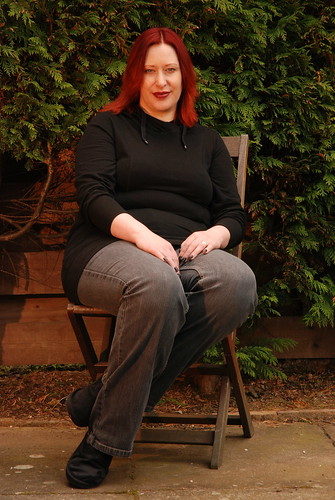
DSC_0008
Nikon D80, Exposure Mode Manual, focal length 46.0mm (35mm equivalent 69mm), aperture f8, speed 1/180 second, ISO 250, Shade white balance, Spot metering, tripod mounted camera, 18-70mm lens, Small flash to the subjects right with a colour balancing sheet fitted on the flash head.
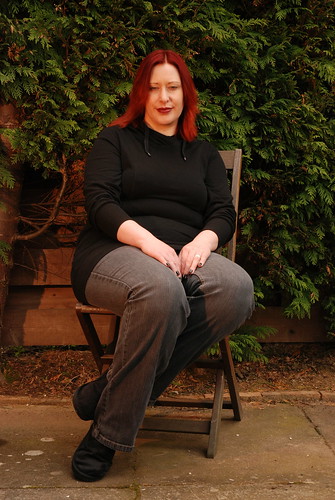
DSC_0005
Nikon D80, Exposure Mode Manual, focal length 18mm (35mm equivalent 27mm), aperture f8, speed 1/180 second, ISO 250, Shade white balance, Spot metering, tripod mounted camera, 18-70mm lens, Small flash to the subjects right with a colour balancing sheet fitted on the flash head.
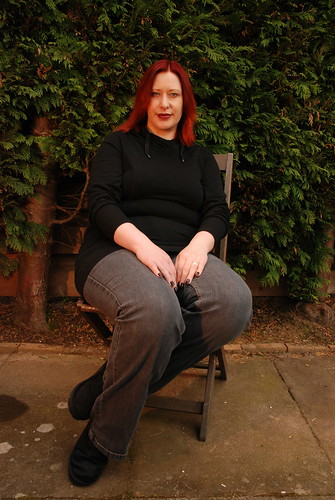
The full portrait was probably the easiest to do as I could practically take all three images using the one lens.
The main issue I had was trying to level the tripod head at each location to ensure that the images were framed in the same way.
In each of these portraits I can see that the lens has had an effect on the overall image and in some cases showing that the lens is unsuitable for that type of portraiture. For example the head and shoulders image shot close up at 18mm distorts the face making it a long distortion in the middle of the image around the nose.
It was fun however to use a different lenses from what I would normally consider which is my prime 50mm f/1.4 lens. It reminded me that I can use different lenses for different situations and that it can help with the creativity to sometimes stand back and photograph from a distance.
No comments:
Post a Comment